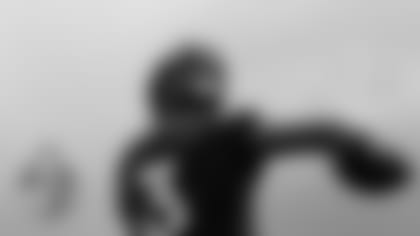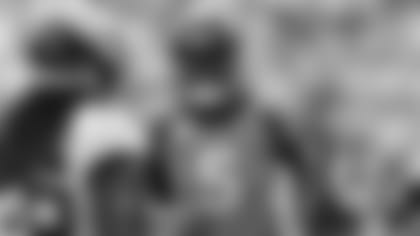As always, you can tweet questions to me with the hashtag #AskMase or use the submission form to your right (if you're viewing on a standard browser) or at the bottom of the page if you're on the mobile site.
**
It seems to me that despite all of the hype about the O-line at the beginning of the season, It's been one of the worst ones in the league (as far as sacks, QB hits, hurries and the running game). What needs to change?**
-- Drew Smith
A good start would be keeping a starting five together. The Broncos had their first-team quintet together for Week 1, the first series of Week 2, and then not again until Thursday night when Donald Stephenson returned. Now Russell Okung is in the post-concussion protocol, which will put his availability for Week 7 into question.
And some of the struggles in the running game and in pass protection don't revolve around the line. It's not one thing; it's not one player, as Head Coach Gary Kubiak has noted, discussing, for example, the role of the quarterbacks in avoiding sacks.
Still, you can't deny the numbers. The hit rate (hits and sacks) is one every 4.2 pass plays, 26th in the league. The sack rate is one every 13.4 pass plays, which is better than only the Bengals, Colts and Dolphins. Neither of those rates are sustainable for success.
Further, the Broncos have been whistled for holding once every 32.8 snaps, the sixth-worst rate in the league going into Sunday. (The NFL average is one every 42.2 snaps.) You can win with a high holding rate; two of the teams ranked worse than the Broncos are Oakland and Seattle.
**
Hi, Mase, I wanted to know what you thought about Thursday's calls? I found the reffing extremely one-sided, 12 penalties on Denver vs 3 on San Diego. At times it appeared Denver lost its cool and deserved them but I thought the call on C.J.'s touchdown was ridiculous.**
-- Adam Daines
First of all, just because there is a discrepancy in penalties called against one team compared to the other, doesn't mean it's one-sided.
That being said ...
The Broncos had nine more penalties and 83 more yards in penalties than the Chargers. Of the 613 games played since the start of the 2014 season, just nine (1.47 percent) have had a greater penalty differential, and only 23 (3.75 percent) have seen a greater penalty-yardage differential.
Further only 11 games (1.79 percent) in that span have seen one team have both at least nine more penalties and at least 80 more yards in penalties than the other.
So it is unusual.
The call that brought back Anderson's touchdown was damaging, but it appeared to be the correct one. Okung wraps up Kyle Emmanuel; he's basically hugging Emmanuel, with his right hand all the way up on the nameplate on his back. You cannot "materially restrict" a defender, and what Okung did would clearly qualify is such.
The one penalty to which I would raise any kind of objection was Matt Paradis' holding call on Anderson's 15-yard run late in the third quarter; it doesn't look like Paradis grabs Tenny Palepoi, but he does get his arms up and brings him down. It's one of those plays that looks like a hold more than it is an actual hold; if Anderson does not gallop immediately to the right of Paradis and Palepoi, it probably goes unwhistled, but with the football right there, the call is made. Paradis is such a technically sound player that any infraction against him is a shock.
I know the lack of holding calls by opposing offensive linemen on Von Miller frustrates Broncos fans; I've read your questions and seen the feedback. More infractions could be called, yes, even though that kind of hold happens on most plays, but if one or two of them had been whistled, you wouldn't be talking about a game with a discrepancy greater than over 98 percent of the games played the last two-plus seasons.
A big part of making that work is the ground game, because the boot is most effective when it's part of the play-action, and part of the complementary football and balance the Broncos want to find on offense. It's also not something you can use on every play, because it limits the scope of the field with which the quarterback can work. That said, it can be an essential part of the offense, and perhaps if the offensive line can find the afore-mentioned cohesion it has lacked so far this season, it can be used more, no matter who the quarterback is.
With the OL struggling does the DL have more depth and could a DL player make a difference on the OL?
-- Frank Fuller
No. A defense-to-offense or offense-to-defense transition isn't something you can do on a whim, nor will it be helpful -- especially when learning on the fly at the highest level. This is not a reasonable solution.
**
I've always enjoyed reading the Mailbag, but I have never felt compelled to write in until now. I was at the Falcons game and was almost embarrassed by the lack of energy from the crowd. I was actually getting heckled by fans in my section who couldn't see the game because I was standing to cheer on our defense and they wanted to sit. The crowd was so flat! I put part of the blame on us "fans" for this loss. Thoughts?**
-- Rob Woodruff
I noticed that once the team fell behind 10-0, the energy in the stadium did not appear the same. Yes, the team feeds the crowd and the crowd feeds the team; when things are going well, the relationship is symbiotic. One thing you like to hear in the locker room after a loss is players taking responsibility -- even if it wasn't the player's fault, there's still the thought that, "I could have done something more; it's on me." And that can extend to fans, as well, even though you're not playing, the organization often speaks of how the fans are part of the team, involved and invested in the outcome.
But if people were heckling you for standing, there's something wrong. This isn't a tennis match or a golf tournament. The best crowds, the most engaged crowds, see plenty of fans standing at key moments -- like when the team is on defense.
I expect the atmosphere to be much less sedate next Monday night against Houston.
Why did the Broncos move Marshall to Trevathan's spot and Davis to Marshall's? Now you have three changes on defense rather than two.
-- Mike Deverich
Because by moving Brandon Marshall to Danny Trevathan's old spot, it put Marshall back in the 3-4 position most analogous to his weakside role in the 4-3 alignment in 2014, when he replaced Trevathan and established his bona fides as a starting linebacker. Further, although there are coverage responsibilities with both spots, the burden is greater on Marshall than Todd Davis, both in terms of snaps and work against the pass. Also, when Trevathan was injured last year, Marshall slid over into that spot.
Submit a question for the next Mailbag!
The analysis, opinion and speculation in this story represents that of the author, gathered through research and reporting, and does not necessarily reflect the opinion of the Denver Broncos organization.

**















